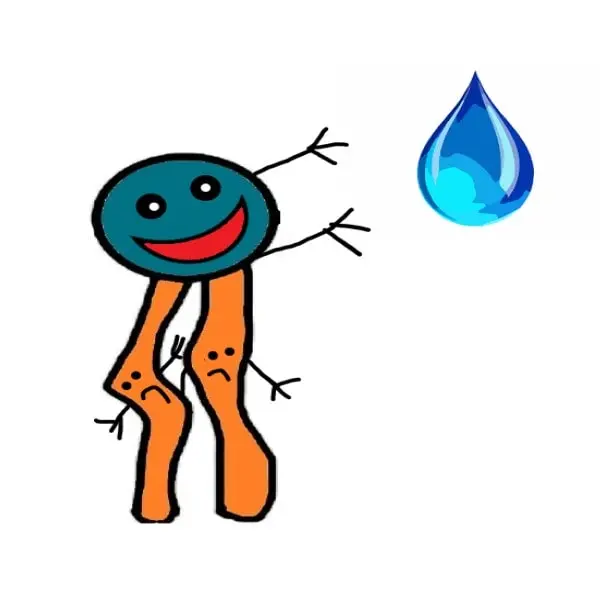
In order to learn the physiological activities of cell and exchange of different molecules across the cell membrane it is necessary to understand how the different components of cell membrane are arranged.
In this post you are going to learn,
- What are the main components of cell membrane?
- Why is the cell membrane is called a fluid mosaic model?
- How these components are arranged in the cell membrane?
- What is the function of cholesterol in the cell membrane?
- How are phospholipids arranged in the cell membrane?
- Function of phospholipids in cell membrane.
- What helps in transport of certain materials across the cell membrane?
- Why is the cell membrane said to be selectively permeable?
- What kinds of molecules pass through a cell membrane most easily?
- Molecules that cannot pass through the cell membrane.
- Types of proteins in cell membrane.
- What are the cell membrane channels and pumps made of?
You can revise your knowledge of CELL STRUCTURE AND FUNCTION by following the link.
Cell membrane is a protective sheath which envelopes whole body of the cell.
Its main purpose is to hold the different cell components together and protect/separate them from environment outside of the cell.
Also known as plasma membrane/plasma lemma/unit membrane.
It is a three-layered structure with the thickness of 7-10 nm/75 Angstrom (lipid layer with thickness of 35 Angstrom where as protein layers with 20 Angstrom).
It is a semipermeable membrane so it can regulate what enters and exits the cell.
So, it does not eject too many nutrients nor absorb too many ions.
The cell membrane is primarily made up of 3 substances
- Proteins (55%)
- Lipids (40%)
- Carbohydrates (5%)
ARRANGEMENT OF DIFFERENT MOLECULES
ARRANGEMENT OF LIPID BILAYER OF THE CELL MEMBRANE
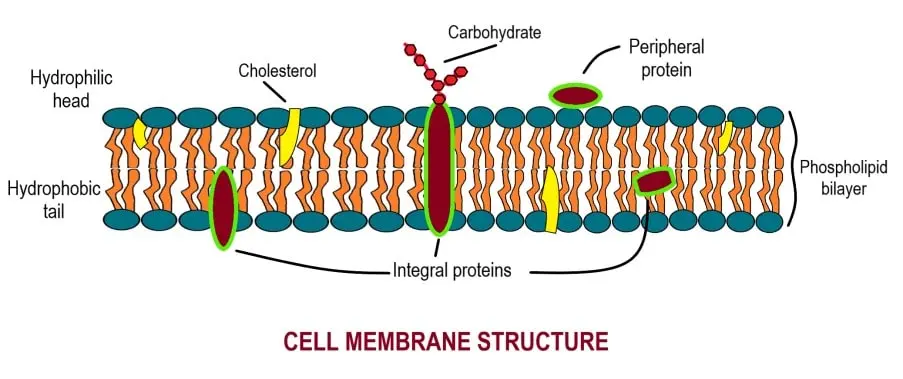
Each lipid molecule of the cell membrane is mainly consisting of phospholipid, cholesterol and glycolipids.
Cholesterol causes the characteristic consistency of olive oil to the membrane.
PHOSPHOLIPID MOLECULE
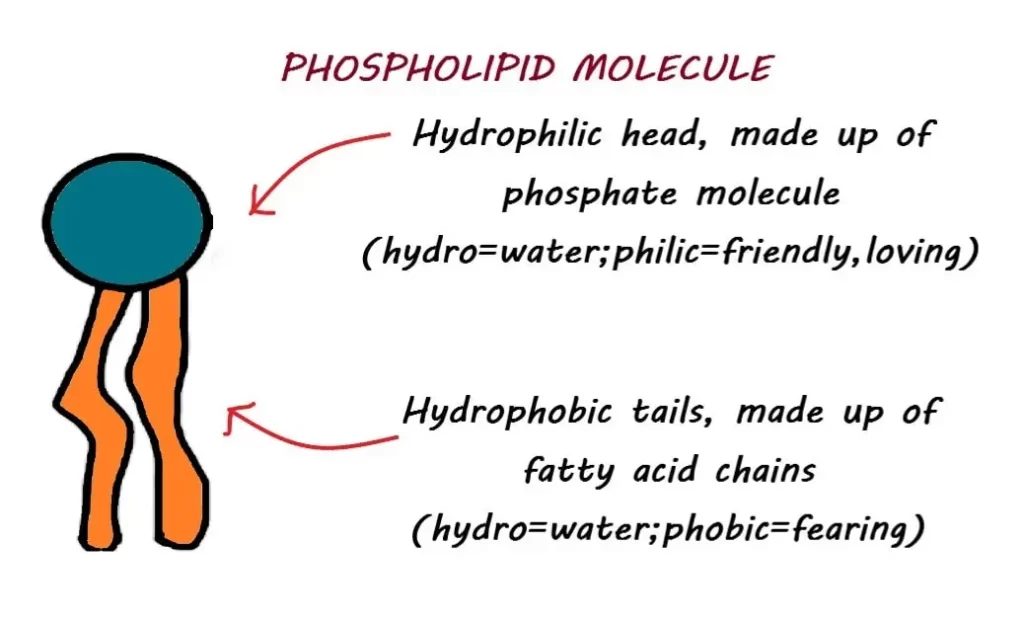
- ONE HEAD: phosphate molecule, water friendly (hydrophilic).
- TWO TAILS: fatty acid chains, repels water (hydrophobic).
Arrangement:
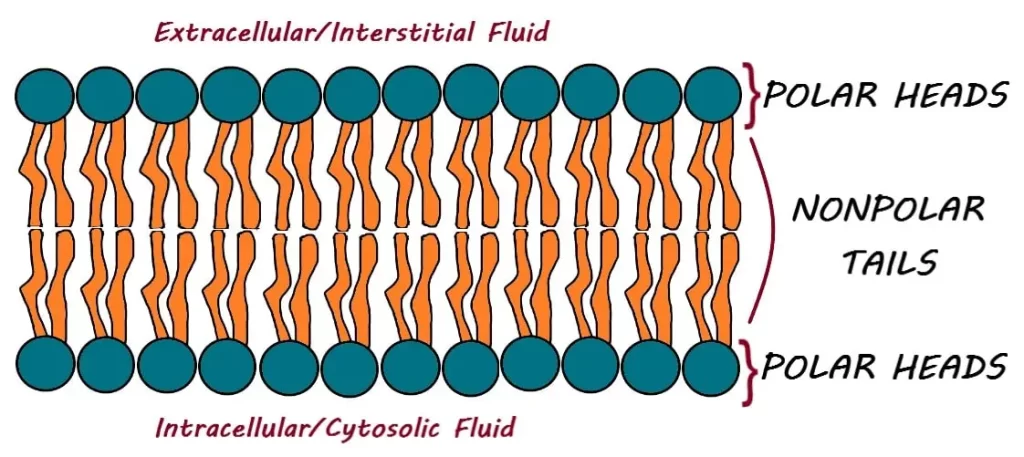
As cell remains in watery solution which we call extracellular fluid and having water inside them which we know as cytoplasm, the arrangement should be in such a way that the hydrophilic head faces the fluid medium on both sides.
So, they make two layers.
Hydrophobic tail ends facing inside the center of the membrane (away from extracellular and intracellular fluid medium).
Head ends facing outside on the both sides of the membrane (facing fluid medium of cytoplasm and extracellular space).
Here are some examples of major phospholipids
- phosphatidyl choline
- phosphatidyl ethanolamine
- glycosphingolipids
- sphingomyelin
- cholesterol.
FUNCTIONS OF THE LIPIDS IN CELL MEMBRANE
- Lipid layer makes cell membrane semipermeable
- Causes a vital barrier for water-soluble molecules like electrolytes, urea and glucose.
- Allows easy movement for fat-soluble substances like oxygen, alcohol or fatty acids across the cell membrane.
What is the role of cholesterol in the cell membrane?
Cholesterol molecules embedded and distributed (randomly) in the cell membrane makes it more stable.
They hold phospholipid molecules together and prevents form separation.
Without cholesterol phospholipids may separate from each other and leave large gapes.
While exposure to cold phospholipids may get close together and make it difficult to pass for small molecules through membrane.
*This is why cholesterol is also an essential part of diet. And most of the skin supplements/products contain fatty acids.
ARRANGEMENT OF PROTEINS IN THE CELL MEMBRANE
Most of the protein molecules float about and form a fluid mosaic pattern.
They can be classified into two major groups
- Integral/intrinsic/transmembrane proteins
- Partially or fully fixed in lipid layers
- They reach from one side to another side of the membrane.
- Acts as enzymes and carriers for ions or water friendly substances (like glucose).
- Peripheral/extrinsic proteins
- Attached to the surface by hydrogen and electrostatic bonds.
- Acts as enzymes and receptors.
FUNCTIONS OF PROTEINS IN CELL MEMBRANE
- Integral proteins provide structural integrity of cell membrane.
- Channel proteins help in diffusion of water-soluble substances like glucose and electrolytes.
- Carrier/transport proteins help in transport of substances across the cell membrane by means of active transport.
- Pump: some carrier proteins actively transport ions across the cell membrane.
- Receptor proteins works as receptor sites for hormones and neurotransmitters.
- Enzymes: some of the protein molecules form enzymes and control chemical reactions within cell membrane.
- Antigen: some proteins act as antigen and induce the process of antibody formation.
THE FLUID MOSAIC MODEL OF CELL MEMBRANE
Widely accepted theory of 1972 by Singer and Nicolson.
It’s about how the cell membrane acts and looks like.
Mosaic means a structure made up of different parts.
Similarly, cell membrane is also made up of many different types of macromolecules like phospholipids, integral and peripheral proteins, cholesterol, glycolipids and glycoproteins etc.
According to this model,
- Proteins are scattered in the lipid bilayer of cell membrane causing its look like mosaic.
- There are no covalent bonds between lipid to lipid or lipid to protein molecules.
- Peripheral proteins literally float on the surface.
- Integral proteins look like iceberg in sea which completely drown in the membrane (have you seen icebergs floating in the ocean on discovery channel?).
- These molecules are constantly motile in two dimensions in a fluid fashion.
- The fluidity of cell membrane is affected mainly by 3 factors.
- Temperature
- Cholesterol
- Saturated and unsaturated fatty acids.A
ARRANGEMENT OF CARBOHYDRATES IN THE CELL MEMBRANE
Carbohydrate molecules are present only on the outer surface of cell membrane in attached with proteins and lipids and making glycoproteins and glycolipids, respectively.
Most are glycoproteins, only 1/10th are glycolipids.
Carbohydrate part of molecule project and swing outside of the cell surface making thin loose covering which we call glycocalyx.
FUNCTIONS OF CARBOHYDRATES IN CELL MEMBRANE
- As they are negatively charged, they restrict passage for negatively charged substances.
- Tight fixation with neighboring cells with one another is possible with the help of glycocalyx.
- Some acts as receptors for certain hormones.
FUNCTIONS OF CELL MEMBRANE
- Protective function: cell membrane protects the cytoplasm and the organelles present in cytoplasm.
- Selective permeability: acts as semipermeable membrane, which allows only some substances to pass through it and acts as a barrier for other substances.
- Absorptive function: nutrients are absorbed into the cell through the cell membrane.
- Excretory function: metabolites and other waste products from cell are excreted out through cell membrane.
- Exchange of gases: Oxygen enters the cell from blood and Carbon dioxide leaves the cell and enters the blood through cell membrane.
- It is responsible for maintenance of shape and size of cell.

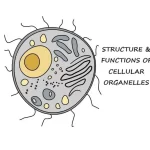
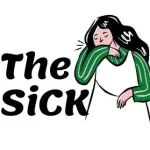










NICELY EXOLAINED